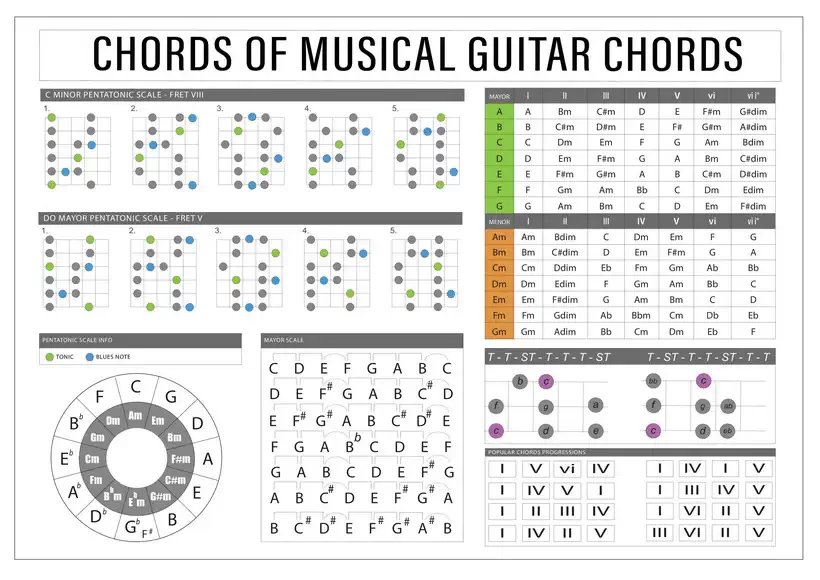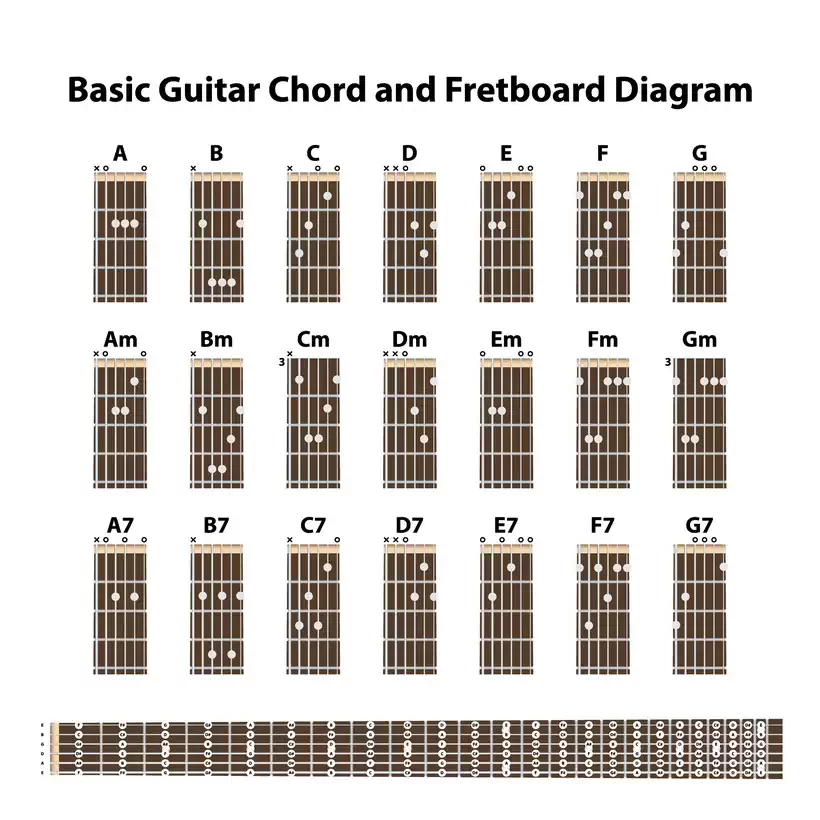If you’re fairly new to guitar, you’re probably trying to learn all the chords you can! Most new players start with three and four-chord progressions. But do you really understand how they work? In this article, we’ll show you how the chords in some common guitar chord progressions work together. You’ll also learn how to use many of these chord progressions in your own music or recognize them in popular music.
Guitar Chord Progressions: What to Know & How to Use Them
You probably already know that a chord progression is, simply put, a series of chords in a specific order. But there’s a specific structure to every chord progression you’ve learned. Here’s what you need to know to better understand chord progressions.
1. Understand The Point
If you’ve ever heard people say that all popular music sounds the same, you aren’t alone. Pop’s critics have a point, though. In the world of pop music, the same progressions are often recycled in different keys. Most have the same upbeat, major sound.
If you find your own songs start to sound the same, you may just be using different guitar chords but following the same chord progression when it comes to the scale degrees. When you understand how chord progressions function, you’ll be better equipped to breathe new life into your songwriting.
Even if you aren’t interested in writing your own songs, understanding the structure of the chord progression of any song lets you effortlessly transpose it. Whether you’re playing in a group that wants to change the key or needs to adjust a song to fit your vocal range, this is an incredibly valuable skill to have.
Knowing how chord progressions work doesn’t just benefit rhythm guitarists; it can also make improvising guitar solos much easier. A given chord progression can be played in any key. So once you have a feel for what the song sounds like, you’ll be able to play lead guitar along with it regardless of the key you pick.
**As a side note, make sure you’re using the right scale to base your solos off! Remember that every major scale has a relative minor. Let’s say you’re playing along with a song in the key of C. You can use the C major scale. The relative minor of C is Am, so you can use either the A minor or C major scale and still sound good. Check out this helpful video if you’d like a brief introduction to how chord progressions work!
2. Make Sure You’re Ready!
When you learn something related to music, always make sure you have a solid foundation before moving forward. For example, most new guitarists start with the chromatic scale (or at least the concept of the chromatic scale) before moving on to the major scale and the minor scale, modes, etc.
Similarly, you’ll want to have a decent familiarity with basic guitar chords before moving into chord progressions. Make sure that you have practiced more than individual chords. Ideally, you will have practiced a few basic progressions to get fairly good at chord changes.
If you still struggle with each chord change or can just play one chord at a time, trying to learn new chord progressions is sure to be frustrating! Be patient with yourself, and make sure you can play chords smoothly before moving on to this next level. Check out this great video lesson if you’d like one guitarist’s opinion on the first seven chords you should learn on guitar.
3. Understanding The Notation

If you’re like most beginner guitarists, you may not even be familiar with the concept of scale degrees. To facilitate the discussion on the interval dynamics in general, instead of individual scales like the D major scale, it is a common practice to assign a special name or number to each individual note of the scale. This is known as the scale degree name. It is an Arabic number from 1 to 7 for a seven-note scale.
For our example, we will use the C major scale, which has no sharps or flats. This is the scale we would use if we wanted to create a chord progression in the key of C:

The seven triad chords are formed by placing each of the scale degrees as the root of the chord. These chords are symbolized by a Roman numeral designation like this:
- C: I
- D: ii
- E: iii
- F: IV
- G: V
- A: vi
- B: viio
As you can see, the numerals just progress from 1 to 7 in Roman numerals.
But to make a chord progression, we need to be more specific. If the Roman numerals are capitalized, that’s a major chord. If they are lowercase, that indicates a minor chord.
There are other additions to indicate seventh chords, diminished chords, etc. But today, we will just focus on major and minor chords. And to keep things simple, we will stay in the key of C major. Check out this helpful video if you’d like a visual introduction to the Roman numeral system and how it works.
4. I IV V — 12 Bar Blues
Lots of the three-chord songs beginner guitarists start out with use I IV V. Despite the name. This progression is not just for blues songs. The I IV V progression is rooted in blues, but many people consider it to be one of the foundations of rock music.
Technically, 12-bar blues is a variant of this simplified progression. It goes like this:
I – I – I – I – IV – IV – I – I – V – IV -I – V
The I IV V progression may well be the first guitar chord progression you learned (or will learn!). After all, when you’re just getting the hang of everything, progressions with three chords help keep things simple.
Let’s look at how to play it in C major. If we were to play I IV V in the key of C, here’s what the Roman numerals would represent:
- I: C
- IV: F
- V: G
The 12-bar blues progression can be found in countless blues and rock songs, but here are some famous ones:
- “Wild Thing” by Jimi Hendrix
- “Stir It Up” by Bob Marley
- “Good Riddance” by Green Day (verses)
5. I V vi IV — The Pop Punk Progression

Despite the name, the I – V – vi – IV progression is used in more than just pop-punk. And if you’re moving on to playing progressions with four chords, this might be one of the first ones you learn.
Let’s find out how to play this progression in the key of C. If we look back at the scale degrees of the C major scale and remember that lowercase Roman numerals mean a minor chord, we get this:
- I: C
- V: G
- vi: Am
- IV: F
Since this chord progression turns briefly to a minor chord and then neatly resolves with a major chord, its overall feel is an optimistic one.
If you want a good example of a song using the pop-punk progression, here are a few:
- “Beast of Burden” by the Rolling Stones
- “I’m Yours” by Jason Mraz
- “No One” by Alicia Keys
6. I vi IV V — The 50s Progression
Despite the name, this common progression can be found in many modern songs. It hearkens back to when doo-wop was popular, but its catchiness has endured.
In the key of C, here’s what each Roman numeral stands for:
- I: C
- vi: Am
- IV: F
- V: G
You probably noticed that this progression uses the same chords as the pop-punk progression — they’re just in a different order. It’s remarkable how different a song can sound when you just change the order of the chords!
So how many songs use the 50s progression? It’s impossible to name them all, but here are some popular songs that use I vi IV V:
- “Heart and Soul” by Larry Clinton feat. Bea Wain
- “I Will Always Love You” by Dolly Parton/Whitney Houston
- “Octopus’s Garden” by the Beatles
7. vi IV I V – The Sensitive Female Chord Progression

This progression can often be found on the sadder side of popular music. Like many four-chord progressions, it’s a good one to move on to if you’re looking for something a little more challenging.
This well-known progression seems to be on every list of easy chord progressions, and it’s a big part of modern music. Its name was coined by a Boston Globe columnist named Mark Hirsh.
As you can likely already tell from the Roman numerals, this one uses the same chords as the preceding chord progressions, just ordered differently:
- vi: Am
- IV: F
- I: C
- V: G
Starting off with a minor chord gives this progression a decidedly sadder feel. But thanks to the return to the V chord at the end, many songs using this progression seem to have at least a slightly hopeful feel.
Here are some famous songs that use this progression:
- “Hello” by Adele (chorus)
- “One of Us” by Joan Osborne
- “If I Were a Boy” by Beyonce
8. ii V I — The Basic Jazz Progression
Jazz musicians tend to work with more chord progressions than you commonly hear in pop songs. The ii V I progression is another guitar chord progression that is especially beginner-friendly.
Jazz chord progressions tend to be more complex than those used in pop. But this relatively simple progression has been used across a whole range of genres, including R&B, country, rock, and classical.
In the key of C major, here’s what each Roman numeral stands for:
- ii: Dm
- V: G
- I: C
As you can see, this is a definite departure from the chord progressions we’ve looked at thus far! With this one, we start with a minor chord that offers a sad, slightly ominous feel. We move immediately to the fifth, so there’s a pretty quick shift to an upbeat, happier chord. Lastly, we reach the tonic. It’s another major chord, making the progression seem completely resolved. In this progression, we are moving down in fifths.
To hear this progression in action, check out these famous songs:
- “Honeysuckle Rose” by Fats Waller
- “Satin Doll” by Duke Ellington
- “Autumn Leaves” by Joseph Kosma
9. I vi ii V I– Another Jazz Standard
The I vi ii V I progression is a little different from the three-chord progression above. It’s a great one to learn if you prefer jazz-leaning progressions.
As you can see from the Roman numerals, this one starts on the tonic and ends on the tonic — a common feature of many progressions.
This standard progression also follows the pattern of major chord/minor chord/minor chord/major chord. This is also a feature that appears in many four-chord progressions. The song’s mood dips slightly with a minor chord before rising back up to the major V before finally resolving to I.
You can also use its minor turnaround, i – VI – iio – V – i, and its 7th chord versions. Including a major sixth before a minor second gives it a very unique character.
To get a better idea of what this progression sounds like, here’s what each Roman numeral stands for if we use this progression in the key of C major:
- I: C
- vi: Am
- ii: Dm
- V: G
This progression isn’t quite as common as some on the list, but it has still been used in some classic songs. Here are a few:
- “Stand by Me” by Ben E. King
- “Crazy” by Willie Nelson
- “Stars Fell on Alabama” by Frank Perkins
10. Using Progressions In Your Own Music
Understanding guitar chord progressions and how they work can really improve your understanding of music theory. And if you write your own songs, learning chord progressions can help you approach your own songwriting with real intentionality. And when you know what the Roman numeral chord progression of a given song looks like, you can easily play it in different keys.
Just like doctors practice on cadavers before operating on patients, dissecting songs you like can help you understand what makes them work on a structural level. That understanding can then help you become a better musician (and songwriter if you write).
However, ensure that knowing these progressions doesn’t have to limit you. When it comes to writing music, there really are no rules — be sure to let your ear guide you. Sometimes, a well-placed, deliberate deviation from a chord progression can really do wonders for a song.
If you want to be able to quickly understand which Roman numerals go with which chords in a given progression, you might consider getting a chord wheel. These wheels show chords in a wheel, but there is a clear overlay. You just need to turn the overlay to select your key. It will show you the Roman numerals for each scale degree so that you can figure out many chord progressions pretty much instantly!
Eventually, you’ll get enough of a feel for the intervals that you may even be able to fill them in without having to consult a chord wheel or look at the major or minor scale you’re using.
Ready to Learn More?
Understanding common guitar chord progressions and how they work can do wonders to improve you as a guitar player. Suddenly, your favorite songs will make much more sense. You’ll also have a general blueprint for writing your own music.
If you want to delve more into chords and chord progressions, an online guitar course can be a great asset. Online courses let you learn at your own pace, and they’re surprisingly affordable too! There’s a course for every genre and skill level. So no matter your experience (or lack thereof), you’ll be able to improve your playing.
Final Thoughts
Hopefully, you now better understand guitar chord progressions and how they work. If you’re just getting into music theory it can be a lot to take in at once. But as you apply what you learn, you’ll soon be able to use your new knowledge without even thinking.
What do you think? Do you have any words of wisdom for newer players? Any tips for learning and using common chord progressions? Let us know in the comments, and please don’t forget to like and share if you found this list useful!


